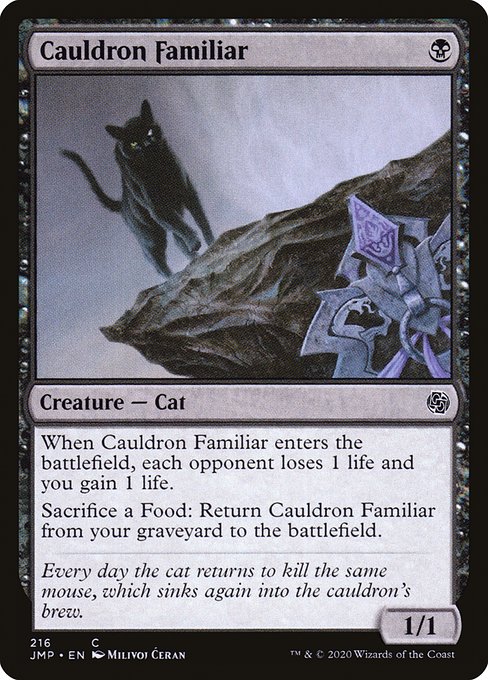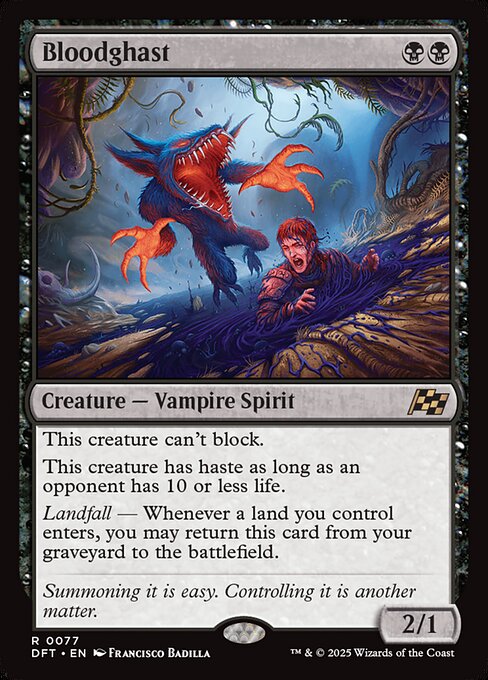Sometimes, the most unassuming cards are Magic’s biggest mistakes. Splinter Twin was initially viewed as a worthless and costly Aura seeded to enable Ally decks, Arcum’s Astrolabe was a cog to facilitate a Snow deck in Limited, and Tarmogoyf was dreamed up as a cheeky way to debut an incoming card type in rules text while referencing a relic of early Magic. There’s no real rubric for “broken card,” as evidenced by the fact that cards banned in multiple formats run the gamut from Skullclamp to Time Spiral to Lurrus of the Dream-Den. Generally speaking, though, if a card is free (either in mana or in cards), produces multiple cards’ worth of value, or can change zones repeatedly without a mana cost, it’s worth putting on the watch list.

2019’s Throne of Eldraine was especially rife with what Mark Rosewater might call “design mistakes” and I would call “reasons to play Magic,” from a mana-free quasi-tutor to a split card of Glacial Ray and Lava Zombie to the best combat Equipment since Umezawa’s Jitte. Cauldron Familiar is not on a level with Oko, Thief of Crowns or even a Once Upon a Time, but it’s proved its worth as part of the Eldraine rogue’s gallery of cards that do too much for too little. In a Standard format rife with Embercleave and Questing Beast and (very temporarily) Uro, Titan of Nature’s Wrath, Cauldron Familiar didn’t make much of a splash, but Rakdos in Pioneer and Historic has used it to great effect, grinding out an extra bit of value from the drain effect and tossing it in a Witch’s Oven to form a glacial but inevitable loop.

That loop was never infinite before now, though–the Oven requires tapping, so you can only create a single Food per turn. Lord of the Rings: Tales of Middle-Earth brought with it an unlikely master for the Cat: Samwise Gamgee. Sam doesn’t care from which zone a creature enters, only that it’s not a token, and so the Cat becomes self-sustaining–every time it reenters the battlefield from the graveyard, it brings along the Food it needs to do so next time. Add any free sacrifice effect, and you have a loop that drains for one each time you run it. As soon as I saw the combo, I tossed four rare wildcards at it, and registered a deck in the format that best suits it: the frontier town of Historic.
Historic is an interesting fit for Cat combo. Cauldron Familiar has been rebalanced in Historic to be unable to block, which removes one of the more annoying aspects of the card in analog formats–unlike other recursive nuisances like Bloodghast or Bloodsoaked Champion, it can chump on the ground. Wizards has moved to an “enters the battlefield tapped” model for this sort of card–Cult Conscript, Persistent Skeleton, etc.–and yet the little cat slipped through, as little cats tend to do. In Pioneer and Modern, the Cat can bounce out of the graveyard mid-combat, drain your opponent for one, and chump-block whatever was coming your way. If you have out a Witch’s Oven or The Shire, you can set yourself up to do it again next turn. It’s a gameplay loop of the sort that Wizards generally wants to avoid: repetitive, frustrating, and, in digital formats, time-consuming to click through for both players. Nonetheless, so long as we can roast the Cat to kill our opponent by a thousand scratches, I’m going to do so.

Once we land a Samwise Gamgee and play a Familiar, any free, repeatable sacrifice effect (Viscera Seer, Woe Strider, Altar of Dementia, etc.) lets us go infinite (or 20+). Personally, I prefer Altar of Dementia, as it helps feed your own graveyard and kickstart the combo, although I see a lot of Sam decks running Woe Strider or Viscera Seer to fix draws, so that’s a consideration. Also worthy of consideration is the fact that keeping our combo enabler as Altar of Dementia lets us run Lurrus of the Dream-Den, giving us a serious incentive to keep our curve low. Sam’s second ability also lets you buy back crucial Legendary creatures or artifacts, including Elas il-Kor or an Altar of Dementia that caught a stray Boseiju, so the deck is remarkably resilient and explosive in later turns. Collected Company will let you find any part of the combo you’re missing at instant speed, or can merely find two copies of Orcish Bowmasters or end-of-turn Bloodghasts for sudden beats.
Without opponent interaction and with a fair bit of luck, the combo can go off as early as turn three: turn one, Cauldron Familiar, turn two Altar of Dementia, turn three Samwise Gamgee and any one-drop to kick off the combo. Not likely, but I’ve pulled it off against an unsuspecting opponent once or twice. That’s rare, though–with Lurrus and Collected Company, you have enough redundancy and resilience that your combo can go off even when disrupted, and you can even sandbag your combo to deploy when your opponent is off-guard, as it costs 2BWG in total.
Here’s where I’ve landed after two weeks of testing:
Companion: Lurrus of the Dream-Den
3 Cauldron Familiar
3 Stitcher’s Supplier
4 Delighted Halfling
4 Bloodghast
3 Orcish Bowmasters
2 Can’t Stay Away
3 Elas il-Kor, Sadistic Pilgrim
1 Fleshtaker
2 Fiend Artisan
4 Samwise Gamgee
4 Altar of Dementia
4 Collected Company
1 Swamp
1 Forest
1 Boseiju, Who Endures
4 Godless Shrine
4 Silent Clearing
4 Blooming Marsh
2 Overgrown Tomb
4 Razorverge Thicket
2 Indatha Triome
The sideboard is in flux, but the core of Thoughtseize, Leyline of the Void, another Boseiju, and more copies of Can’t Stay Away hasn’t changed. I’ve been playing Battle of Bywater in the ‘board, as well, which overperforms, but only against decks you’re favored against pre-sideboard. I imagine I’ll move up to more artifact and enchantment hate, as cards like Leyline of the Void, Unlicensed Hearse, and Grafdigger’s Cage are very well-positioned against the deck.
It feels amazing to be running Bloodghast in Historic–all of the various Mill decks, Liliana of the Veils, and incidental discard you run into entering random Ranked events in the format mean you can suddenly present four to eight damage off a topdecked land, and the Vampire Spirit is great fodder for Fiend Artisan. All of that said, this deck is a graveyard combo deck, and it’s weaker to disruption than some other decks in that category–Yawgmoth combo can fight through a Leyline, while this effectively rolls over.

Speaking of Yawgmoth Combo–is this possible to replicate this deck in Modern? Without Lurrus, we have the consolation of running three drops, including Tyvar, Jubilant Brawler, who is almost as good as Lurrus in this build. From initial testing, though, this is a faster but worse version of Yawgmoth Combo in Modern–while you potentially shave a turn off of the combo with a perfect hand, Yawgmoth can play a card advantage game even if the infinite combo is disrupted. Samwise/Familiar combo is basically all-in and is easy to disrupt. A well-timed Surgical Extraction or a Hushbringer shuts the entire deck down, and you’re attempting to win with various vanilla 2/2’s. I do think it’s possible to fuse the two together and run both Samwise/Familiar and Yawgmoth/Undying loops, and I’ve started testing a hybridized Yawgmoth/Cat deck that shows promise. Splashing a third color is effectively free in Modern, and the Sam/Cat loop gives the deck another plan of action against the mirror.
Samwise Gamgee, in The Lord of the Rings, was a talented gardener and devoted servant to Frodo Baggins (Tolkein, a man with a boundless imagination for imagining fantasy worlds but limitations in imagining a better real world, replicated the exploitative class structures of his native Britain in his fantasy Shire), someone whose bravery and devotion were balanced by his humble aspirations. He didn’t want to rule the world, or even the Shire–he wanted a patch of land, an overstuffed chair by a fire, and the love of his intended. Instead, we’ve given him an immortal cat and a role as an amateur necromancer, a torment he’d find as baffling as it is cruel.
Rob Bockman (he/him) is a native of South Carolina who has been playing Magic: the Gathering since Tempest block. A writer of fiction and stage plays, he loves the emergent comedy of Magic and the drama of high-level play. He’s been a Golgari player since before that had a name and is never happier than when he’s able to say “Overgrown Tomb into Thoughtseize,” no matter the format.

